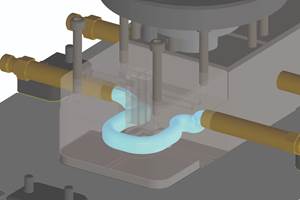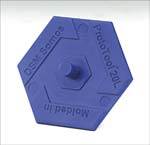Additive Fabrication Technology
Why you should be aware of it and where it’s headed.
Additive fabrication technology has been available since the late 1980s with the invention of stereolithography (SL). Rapid prototyping is the technology’s most popular application and many continue to use this term to describe it. Several additive processes have since been introduced, helping to expand the number of applications and the industries that are using the technology.
Additive Processes: Then and Now
Even in the early days, additive processes were much faster than alternative methods of producing physical models. Yet, they were not all that rapid, especially when you consider the preprocessing of the 3-D CAD model data, the speed of the build process, and the post processing of the parts. Also, the parts were not terribly accurate nor were they strong, which limited their usefulness.
Times have changed. Today, systems are fast and relatively easy to use and they produce parts that are used for very demanding applications. Durable materials are available that help make it possible. A growing number of companies are even using the technology for short-run production.
Additive processes have dramatically changed the business of building models and prototype parts at countless companies. For example, the number of modelmakers at Graco Children Products was reduced from seven to five over a span of about two years. During this time of staff reduction, the company built up its arsenal of tools that has allowed it to complete a staggering 10 times the amount of work, according to Michael Zerbe of Graco. Several additive processes have helped the company achieve this feat including a 3-D printer from Z Corp., a Prodigy fused deposition modeling (FDM) system from Stratasys and two PolyJet (Eden333) 3-D printers from Objet Geometries. The group also is running a CNC mill and router.
Meanwhile, a large consumer products company (that wishes to remain anonymous) went from an estimated 200 modelmakers and machinists to just six in less than 10 years. Two individuals currently oversee the company’s FDM, PolyJet, SL, laser sintering (LS) and CNC equipment, which currently meets 90 percent of the modeling and prototyping needs domestically. The group is capable of processing an impressive four to five projects per day and offers 24-hour and same-day service. The company delivers 1,500 new products per year, an estimated one-third of which benefit directly from additive fabrication. Without this technology, it would be impossible to handle anything close to what it’s accomplishing today.
At organizations such as Graco and others, product development usually occurs at different locations and manufacturing facilities are often located on the other side of the world. Working with overseas vendors, suppliers and manufacturing partners presents communication challenges that make efficient collaboration difficult. International partners often use different CAD systems and are asleep when design engineers are awake, and vice versa. CAD files, 3-D images, e-mail and teleconferences can be effective for supporting design reviews, but nothing boosts communication with suppliers on a worldwide scale like physical parts. Increasingly, manufacturers are using parts from additive processes to facilitate and streamline interaction with partners located around the globe.
Moldmakers and others in product development and manufacturing have found that using models to communicate reduces the likelihood of errors and miscommunication with customers. The technology permits them to get their hands on the design, define parting lines, suggest design improvements, and produce a plan that reduces the chances of major surprises and delays. When considering the time and cost that can go into mold, the relatively low cost of a model can pay back many times over.
Rapid Tooling
R&D groups at companies, universities and research institutes in the U.S. and abroad have created methods of “rapid tooling” that involve an additive process. Not all, but most of them have not been very successful in competing with CNC machined tooling. Consequently, developments in rapid tooling have declined dramatically throughout the past two to three years. Today, these unconventional approaches are anything but popular, but customers have shown that they do make sense to consider in some instances. Consequently, the activity has not disappeared entirely and some companies continue to have high hopes for the production of tooling inserts using additive processes.
Methods of producing high-performance tools with additive technology have generated the most interest in the recent past. With high-performance tools, molding cycle time is more important than the time it takes to produce the tool. EOS, ProMetal, and others are applying ideas and technologies to the creation of tooling that reduces the cycle time of molding plastic parts or die casting metal parts. When done successfully, these time and cost savings can dramatically outweigh the benefits of producing tools quickly.
Beyond cost and time reduction, some advanced methods of tooling offer a potential benefit of improved thermal properties that cannot be realized with conventional machined tools. One such beneficial method is to create conformal-cooling channels within the tool. These channels allow coolant to pass through the mold in a pattern that conforms to the shape of the mold cavity. Conformal cooling removes heat from the mold or die faster than the straight-line channels in machined tools, which can reduce injection-molding and die-casting cycle times. Tests suggest that conformal cooling can reduce cycle time by 20 percent or much more, improve part quality, and have a significant impact on part cost and production rates.
Rapid Manufacturing
Rapid manufacturing is the next frontier. A number of companies in aerospace, military, motor sports, medicine, dentistry and consumer products are now using additive processes for manufacturing support and series production applications. Among them are BAE Systems, Boeing, Caterpillar, Northrop Grumman, Renault Formula 1, Siemens Hearing Instruments, and many lesser-known companies. Organizations that are most successful with it are those that produce high-value products in relatively low quantities.
An example is the new European built Vega launcher that will include FDM polycarbonate parts in each of its engines in all three stages of the rocket. The launcher will put 300 to 2,500 kg (661 to 5,512 lb.) satellites into polar and low-earth orbits and will be used for scientific and earth observation missions. These highly complex parts are being manufactured on a Stratasys Titan machine, according to Jorn Berends of JB Ventures BV in the Netherlands. The parts serve as consumable igniters that contain the fuel for starting each rocket stage. Polycarbonate works well because it is rigid and strong, can withstand high temperatures, and burns away when necessary. Vega is expected to be launched near the end of 2006 or beginning of 2007.
Impact on Moldmaking
Will rapid manufacturing impact the business of moldmaking and conventional manufacturing processes such as injection molding? The simple answer: Not a lot in the short term. However, in special cases, it certainly will and it already has. Using additive fabrication to manufacture will mainly impact organizations that produce complex products. If the shape of the product is difficult to manufacture using a conventional process, and if the materials that are available meet the need, additive processes will likely play a role. Other considerations are surface finish, feature detail and cost of the material. The technology also will help companies that want to offer custom, semi-custom or personalized products—areas of growing interest.
Countless product development groups around the world have benefited from additive fabrication technology. Many use it as an effective method of communication, while others benefit from the parts for fit and function applications. Moldmakers use the technology to help reduce the likelihood of discovering problems that can occur when changes are expensive. Rapid tooling has not developed like some had expected, but there are situations when it makes sense to consider. Meanwhile, a growing number of companies are applying additive processes to the production of relatively small production quantities, especially in cases where product complexity and value are high.
In future issues of MoldMaking Technology, industry experts will address many of the topics presented in this article. If you have an idea or story that you would like to share, feel free to contact Christina Fuges.
Related Content
How to Supply Cooling to Additive Tooling
Additive tooling provides limitless options for cooling a mold’s difficult-to-cool areas.
Read MoreBuilding Molds: Most Popular Reads of 2024
Dive into the most-viewed content for building your mold, including topics such as cutting tools, EDM, hot runners, additive manufacturing, mold materials, machining and mold components.
Read MorePrecision Meets Innovation at IMTS 2024
After attending IMTS, it's clear that the integration of advanced technologies is ready to enhance precision, efficiency and automation in mold manufacturing processes. It’s a massive event, so here’s a glimpse of what the MMT team experienced firsthand.
Read MoreMold Materials, 3D Printing Technologies for Next-Gen Moldmaking
As moldmaking advances, so too do the materials and processes involved in their efficient production, including these latest mold materials and 3D printing technologies.
Read MoreRead Next
Integrating Rapid Prototyping With the Shop Floor
The CNC-based RP process works to complement existing production techniques.
Read MoreRapid Tooling Via Stereolithography Gets a Closer Look
Industry roundtable reports initial findings.
Read MoreHow to Use Strategic Planning Tools, Data to Manage the Human Side of Business
Q&A with Marion Wells, MMT EAB member and founder of Human Asset Management.
Read More




















